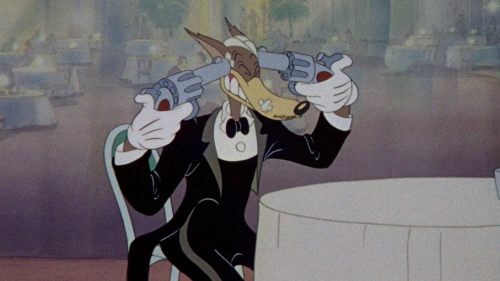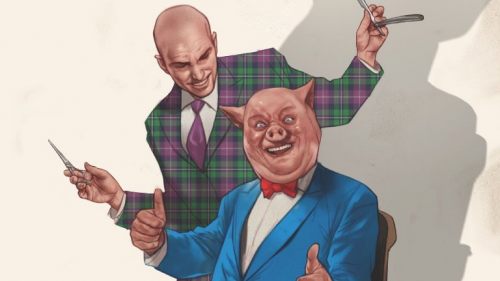Sam And Ralph And The Contagious Idealism Of Chuck Jones
With one perfect gag, Chuck Jones gave me a completely unrealistic idea about society.
Jones and writer Michael Maltese open the 1955 cartoon Double or Mutton with an indelible image: Sam Sheep-Dog and Ralph Wolf, carrying working-man lunches in basic pails, approach a time-clock. "Morning, Ralph," the dog says. "Morning, Sam." Sheepdog and wolf, natural enemies, walk into work as colleagues (eventually friends), where they allow their violent instincts to run wild. When the five-o’clock whistle blows, they slip the masks of society back on -- or they remove their bloodthirst.
More so than any of the many contagious concepts in Warner Bros. cartoons, I’ve internalized this image so deeply that it has the weight of truth. In an uncritical image of Sam and Ralph, the characters represent a vanished decorum, an aspect of American society that withered as the 20th century marched on.
That conception is wrong. Jones’s joke, like so many interactions envisioned in his films, is a fantasy -- at best a wild exaggeration of some nugget of truth. These cartoons were created in an age of segregation and McCarthyism. They’re a reaction to a society that let the Hollywood Blacklist rage, a society already simmering with conflicts that would boil over in decades to come.
Maybe some well-to-do white guys in America could believe in the dual identities of Sam and Ralph as a livable ideal. Don Draper could perhaps believe in this image, but we know what Don is really like with truth, and decorum.
What about that nugget of truth? Sam and Ralph play out questions of identity and ethics, core aspects of human civilization. What defines us as individuals? Are we fundamentally governed by our most basic, inherent instincts, or are we actually creatures capable of creating a society?
With a handful of drawings and two lines of dialogue, Jones and Maltese distill an essential human question into one minute of cartoon footage.
I imagine the tension between these animals as a variation on the scene in Heat where the Pacino and De Niro characters sit down together. The core identities of those characters are tied to their professions. Any decorum is a pause, a mask. Are Sam and Ralph fundamentally animals who would kill one another given the chance, or are they actually mutually respectful colleagues?
Zootopia revisits the Ralph and Sam concept by imagining a shared space in which animals set aside natural instincts to create a better space for many species. They trade impulse for security, and any hint that wild impulses could reassert as dominant behavior becomes a threat.
The first Sam and Ralph cartoon isn’t even really a Sam and Ralph cartoon. In "Don’t Give Up the Sheep" we see two sheepdogs, neither called Sam, working sheep-watch shifts. The wolf -- a version of Wile E. Coyote almost down to the last detail -- is the antagonist, not a co-worker. A year later, Sheep Ahoy had the idea of wolves working in shifts, too.
Over the course of ten years and seven cartoons, from 1953 to 1963, Jones, Maltese, and a few other creators evolved the concept, stretching and pulling, to explore the same gags in new ways.
Sam and Ralph begin "Steal Wool" (1957) emerging from houses facing one another along a fine street; they’re comfortable in success. Before the work whistle blows, Ralph pushes his features into a more “animal” expression, like the “let’s get into character” beat in Pulp Fiction. In other installments, Sam is a stumblebum who trips over his own feet when not at work. On the job he turns into Mike Ehrmantraut, stoic, powerful, ultra-capable.
Lest anyone think Jones was just working out a gag, the director later said, “The story of Ralph and Sam comes down to Lewis Brown’s idea that there are no judges, only people judging, no tramps, only people tramping, and so on. What does a judge do when he gets home at night?”
I admire Jones’s optimism. That quote suggests the “reality” of the characters is the one in which they walk home together at night, where Sam offers to handle both his own next shift and the wolf’s after doling out a particularly severe beating at work.
The example of Sam and Ralph may be a fantasy, but I’m going to keep it in my pocket as an ideal. We’re always at one another’s throats, but the dream is that we don't have to be. We can find a space to explore and express our differences, but still shake hands across the aisle, and go home as colleagues, rather than cowering alone like animals.



